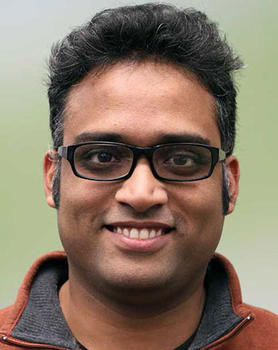Human trafficking is a global crisis of overwhelming scope. Fortunately, anti-trafficking organizations can use AI to predict the criminals’ next moves–with the help of a George Mason University professor.
The fight against human trafficking has a David and Goliath aspect to it. Trafficking rings are a global scourge with an estimated 25 million victims and $150 billion in annual profits. Agencies and NGOs tasked with stopping the traffickers, however, are typically small and under-resourced. Recently, a technological tool has come along to help close this gap–machine learning (ML) algorithms.
Primed with enough relevant data, these algorithms can find hidden clues to how traffickers operate and what they are likely to do in the future. In principle, anti-trafficking agencies can use ML predictions to direct their scant resources to the areas of greatest risk.

Abhishek Ray, an assistant professor in the Information Systems and Operations Management area at the George Mason University School of Business, has added his expertise to this effort. With collaborators Viplove Arora (post-doc researcher at SISSA, Italy), Kayse Maass (of Northeastern University) and Mario Ventresca (of Purdue University), Ray developed a model that reduces the guesswork of implementing ML predictions.
As Ray explains it, the model supplies a “layer on top” for improving outcomes of existing ML solutions. Armed with success and failure rates (i.e., true/false negatives and positive trafficking detections) of an anti-trafficking agency, it looks for scenarios in which the agency could achieve the same number of successes with fewer errors.
In a recently published paper, Ray and his co-authors apply their model to two real-life agencies: Global Fishing Watch (GFW), which targets trafficking in the global seafood industry, and Love Justice International (LJI), which monitors transit stations on the India-Nepal border.
The ML solution employed by GFW cross-references a large database of fishing vessel activity, which is obtained via satellite, with law enforcement data on human trafficking. The resulting predictions indicate the vessel types, behaviors, and features that the agency should watch most closely.
But criminals sometimes learn faster than machines. “If someone is caught on a long trawler, and they know they can get caught, they will never go on the long trawler again,” Ray explains. Traffickers’ evolving tactics may not be fully captured in vast, wide-ranging data-sets, such as the ones derived from satellite vessel surveillance. Changes in agency success rates, on the other hand, are closer to the action and may pick up the latest stages of this cat-and-mouse game.
Looking back over agency data from 2012-2018, the researchers found that had their model been used alongside ML, GFW would likely have discovered more instances of trafficking while committing far fewer false negatives and false positives. In addition, monitoring recommendations shifted considerably over the six years. For example, under certain conditions, drifting longline vessels were the most likely suspects for the years 2012-2017. In 2018, however, squid jiggers replaced them and were singled out as among the most suspicious. These shuffling priorities may reflect the traffickers’ changing their vessel of choice to evade detection.
In the case of Love Justice International, Ray’s model could serve as a workaround for constraints such as a shortage of well-trained staff. LJI could input a target outcome into the algorithm, such as a baseline number of positive trafficker IDs, and receive recommendations for how to make the best use of strained resources.
For Ray, the fight against human trafficking is personal. As a child growing up in Kolkata, India, he was cared for by a household employee who, as his parents later found out, had been trafficked when she herself was a child. “I learned this when I was doing my PhD in the U.S.,” he says. “It’s like having a part of your childhood taken away. You came into contact with something criminal and had no understanding.”
“If I could make a contribution towards solving the problem, I’d consider it sort of giving back what I had taken unknowingly.”
To take full advantage of Ray’s “layer on top” ML solution, anti-trafficking agencies would need to create effective systems for collecting and centralizing data. Depending on the context, this might present challenges ranging from resource limitations to a political climate where trafficking data could be used against the already-victimized. “The maximum value from our framework is when it’s acting in real time with real-time data,” Ray says.
- May 28, 2025
- May 23, 2025
- May 7, 2025
- May 5, 2025
- April 30, 2025
